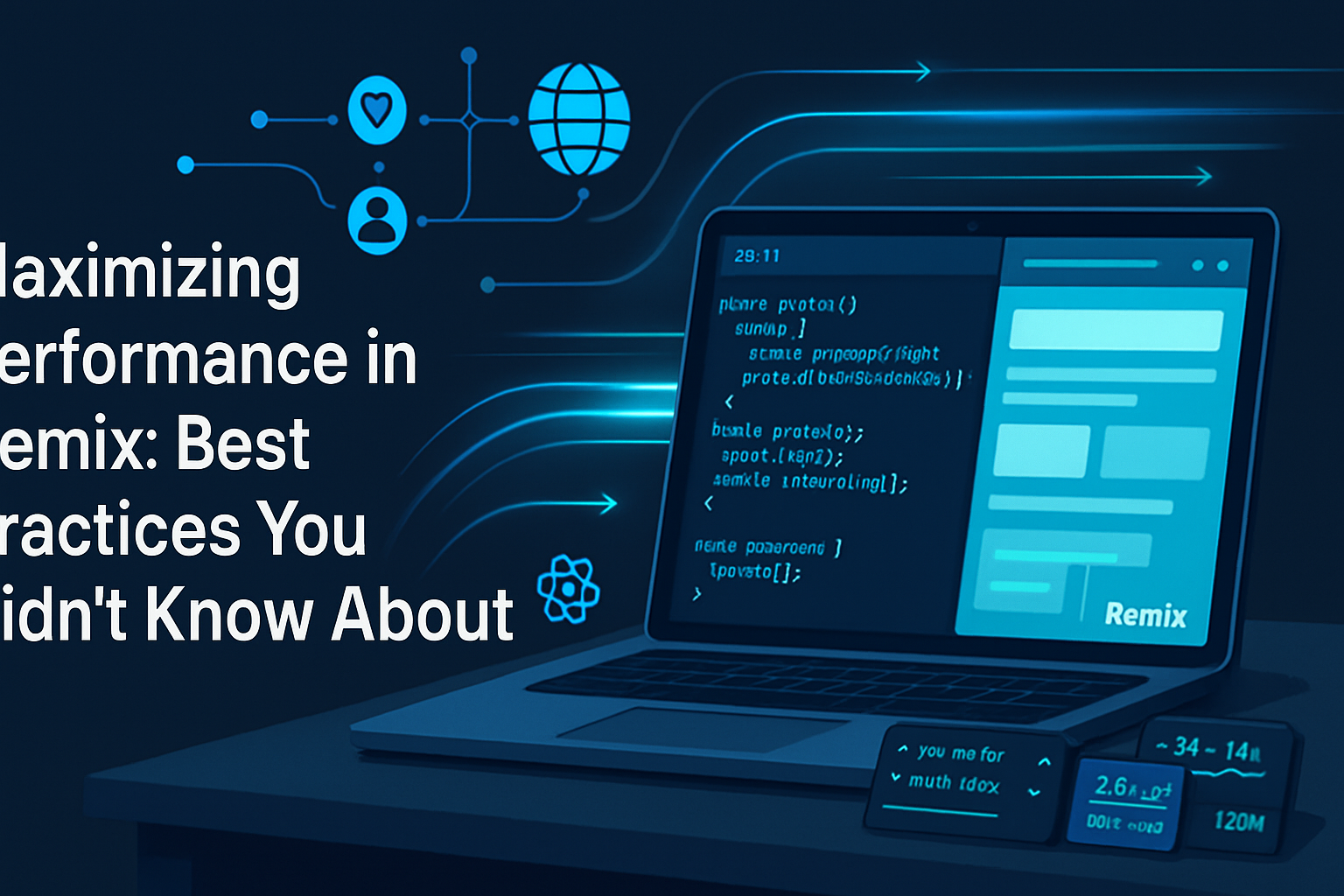· frameworks · 8 min read
Maximizing Performance in Remix: Best Practices You Didn't Know About
Explore advanced, lesser-known Remix performance techniques - from HTTP/CDN caching, ETag handling and edge caching to defer/Await streaming, parallel loaders, route-level lazy loading and avoiding data waterfalls - with real-world examples that yield faster load times and better UX.

Why performance in Remix matters (and what’s different)
Remix ships with thoughtful defaults for route-based code-splitting, progressive enhancement, and server-first data loading. But to get consistently snappy real-world apps you need to combine Remix primitives with web-performance techniques most teams either forget or never discover.
This post focuses on practical, lesser-known optimizations you can add today: HTTP/CDN caching patterns, ETag handling, streaming/deferred data with defer + Await, parallel loaders to avoid request waterfalls, lazy-loading large components (and keeping server code off the client bundle), prefetch strategies, and real-world examples tying them together.
References used throughout:
- Remix docs: loaders, defer, and routing - https://remix.run/docs
- MDN: Cache-Control header - https://developer.mozilla.org/en-US/docs/Web/HTTP/Headers/Cache-Control
- React code splitting (React.lazy + Suspense) - https://reactjs.org/docs/code-splitting.html
Core principles before optimizing
- Treat the server-rendered HTML as the most important resource. Get it fast.
- Avoid large client bundles by keeping server-only code in loaders/actions and not importing it into components that run in the browser.
- Reduce blocking network requests (waterfalls) by parallelizing and streaming data to the client.
- Use HTTP caching (Cache-Control, ETag) and CDNs - they are the single biggest win for repeated visits.
1) HTTP + CDN caching strategies you may be missing
Remix gives you full control over response headers. Use that!
- Use
Cache-Controlto tell CDNs and browsers how to cache assets and HTML. For cacheable HTML fragments, uses-maxagefor CDN TTL andstale-while-revalidateto serve slightly stale content while revalidation happens in background. - Use ETag / Last-Modified to cheaply respond with 304 Not Modified.
- Cache static assets aggressively at build time (fingerprinted filenames) and HTML at the edge when it makes sense.
Example: set caching headers from a loader (basic pattern)
// app/routes/posts.jsx
import { defer } from '@remix-run/node';
import { getPosts } from '~/models/posts.server';
export const loader = async ({ request }) => {
const postsPromise = getPosts(); // do not await, allow streaming/parallel
return defer(
{ posts: postsPromise },
{
headers: {
// CDN caches for 60s, allow serving stale while revalidating for 5 minutes
'Cache-Control':
'public, max-age=60, s-maxage=60, stale-while-revalidate=300',
},
}
);
};Notes:
s-maxagetargets shared caches (CDNs/edges),max-agetargets browsers.stale-while-revalidatelets you be forgiving and fast.- Configure your CDN (Vercel/Cloudflare) to respect origin headers.
ETag example (manual 304 handling)
import crypto from 'crypto';
import { json } from '@remix-run/node';
import { getPosts } from '~/models/posts.server';
export const loader = async ({ request }) => {
const posts = await getPosts();
const body = JSON.stringify(posts);
const etag = `W/"${crypto.createHash('md5').update(body).digest('hex')}"`;
if (request.headers.get('if-none-match') === etag) {
return new Response(null, { status: 304, headers: { ETag: etag } });
}
return json(posts, {
headers: { ETag: etag, 'Cache-Control': 'public, max-age=60' },
});
};Why this matters:
- CDNs and proper cache headers drastically reduce TTFB for repeat visitors and global users.
2) Stream and defer data for faster perceived loads
Remix’s defer (server) + <Await> (client) pattern lets you stream fast HTML with critical data while lower-priority data loads in the background. Use it to prioritize above-the-fold content.
Loader using defer:
// app/routes/dashboard.jsx
import { defer } from '@remix-run/node';
import { getProfile } from '~/models/user.server';
import { getFeed } from '~/models/feed.server';
export const loader = async ({ request }) => {
const profilePromise = getProfile(request); // critical
const feedPromise = getFeed(); // heavy, can stream
// Return profile immediately (await), stream feed (defer)
return defer({ profile: await profilePromise, feed: feedPromise });
};Client: consume with <Await> and show skeletons
import { useLoaderData, Await } from '@remix-run/react';
import { Suspense } from 'react';
export default function Dashboard() {
const data = useLoaderData();
return (
<div>
<Profile data={data.profile} />
<Suspense fallback={<FeedSkeleton />}>
<Await resolve={data.feed}>{feed => <Feed items={feed} />}</Await>
</Suspense>
</div>
);
}Why this matters:
- Users see meaningful content sooner. Heavy lists, comments, or recommendation engines can stream later without blocking the initial render.
3) Avoid waterfalls - parallelize everything
A waterfall happens when your loader awaits several fetches sequentially. Instead, start all requests and await together.
Bad (waterfall):
const user = await getUser();
const posts = await getPostsForUser(user.id); // waits for userGood (parallel):
const userPromise = getUser();
const postsPromise = getPostsForUser(someId);
const [user, posts] = await Promise.all([userPromise, postsPromise]);Even better: combine with defer to stream noncritical promises.
Why this matters:
- Network latency compounds across sequential requests. Parallelization cuts total wait time down to the slowest call.
4) Lazy-load heavy components and keep server code off the client
Remix’s route-based code-splitting is powerful, but you also get wins by lazy-loading big UI chunks and ensuring server-only code stays server-only.
- Use dynamic imports + React.lazy for large widgets (graphs, WYSIWYG editors, analytics dashboards).
- Put database or secret-dependent code only in loaders/actions. If you import server utilities into a module that also exports a React component, bundlers may include them in the client bundle.
Example: lazy-load a heavy comments UI
import React, { Suspense } from 'react';
const RichComments = React.lazy(() => import('~/components/RichComments'));
export default function Post() {
return (
<article>
<PostContent />
<Suspense fallback={<div>Loading comments...</div>}>
<RichComments />
</Suspense>
</article>
);
}Tip: keep server code in app/models/ and only import those files from loaders/actions. Avoid importing models/* inside components that are rendered on the client.
Why this matters:
- Lazy-loading reduces initial JS payload. Keeping server code out prevents accidental client bloat and leaking secrets.
5) Prefetching and Link strategies in Remix
Remix <Link> supports prefetch behavior. Use it wisely.
prefetch="intent"fetches data and module when the user indicates they’ll navigate (e.g., hover or focus). It’s a great balance between network use and UX.prefetch="render"prefetches immediately - use carefully for high-probability navigations like primary CTAs.
Example:
import { Link } from '@remix-run/react';
// Prefetch data and route module on hover
<Link to="/posts/123" prefetch="intent">
Read more
</Link>;Also consider resource hints for critical assets (<link rel="preload">) and prefetching fonts/critical images.
Why this matters:
- Prefetch on intent makes navigations feel instant without prefetching the entire site.
6) Efficient client-side fetching: useFetcher + dedupe + cache
Remix useFetcher is perfect for background data loads that shouldn’t cause navigation. Combine it with client caches or in-memory dedupe to avoid duplicate requests.
Pattern: use a small client-side cache keyed by URL/params, return cached value immediately and let useFetcher.load() revalidate in the background for SWR-style UX.
const cache = new Map();
function useCachedFetch(url) {
const fetcher = useFetcher();
const cacheKey = url;
useEffect(() => {
if (!cache.has(cacheKey)) {
fetcher.load(url);
} else {
// optional: set local state from cache
}
}, [url]);
useEffect(() => {
if (fetcher.data) cache.set(cacheKey, fetcher.data);
}, [fetcher.data]);
return {
data: cache.get(cacheKey),
loading: fetcher.state !== 'idle' && !cache.has(cacheKey),
};
}Why this matters:
- Avoids duplicate requests and yields snappy UX by reusing cached responses.
7) Images, fonts and other asset strategies
- Use responsive
srcsetand modern formats (AVIF/WebP) via an image CDN. - Lazy-load offscreen images with
loading="lazy"anddecoding="async". - Preload hero images and critical fonts.
Example lazy image:
<img src="/images/hero.jpg" loading="lazy" decoding="async" alt="..." />Why this matters:
- Images are often the largest payload; optimizing them accelerates paint and reduces bandwidth.
8) Real-world example: Blog post page (posts + comments)
Goal: render the post content fast, stream comments, use CDN caching for posts, lazy-load rich comment UI.
Loader (combined techniques):
// app/routes/posts/$slug.jsx
import { defer } from '@remix-run/node';
import { getPostBySlug, getCommentsForPost } from '~/models/posts.server';
export const loader = async ({ params, request }) => {
const postPromise = getPostBySlug(params.slug); // critical
const commentsPromise = getCommentsForPost(params.slug); // heavy
// Set CDN cache for post page (short TTL) but allow stale while revalidate
return defer(
{ post: postPromise, comments: commentsPromise },
{
headers: {
'Cache-Control':
'public, max-age=30, s-maxage=60, stale-while-revalidate=300',
},
}
);
};Component (consume and lazy-load comments UI):
import { useLoaderData, Await } from '@remix-run/react';
import { Suspense } from 'react';
const RichComments = React.lazy(() => import('~/components/RichComments'));
export default function PostSlug() {
const data = useLoaderData();
return (
<main>
<article>
<h1>{data.post.title}</h1>
<div dangerouslySetInnerHTML={{ __html: data.post.body }} />
</article>
<section aria-live="polite">
<h2>Comments</h2>
<Suspense fallback={<div>Loading comments preview...</div>}>
<Await resolve={data.comments}>
{comments => (
<Suspense fallback={<div>Loading full comment UI...</div>}>
<RichComments comments={comments} />
</Suspense>
)}
</Await>
</Suspense>
</section>
</main>
);
}What this achieves:
- The post content shows quickly because
postis awaited whilecommentsstream. - The heavy
RichCommentsbundle is lazy-loaded on-demand. - Cache headers encourage CDN caching of the page for repeat visitors.
9) Measuring improvements and keeping regressions away
- Use real-user metrics (RUM) like Largest Contentful Paint (LCP) and Time to First Byte (TTFB).
- Lighthouse and WebPageTest for lab measurements.
- Track bundle sizes (source-map-explorer or vite/webpack bundle analyzer) and monitor server response headers.
10) Quick checklist you can apply now
- Move DB/secret logic into loaders/actions and never import server modules into client-rendered components.
- Add Cache-Control + s-maxage + stale-while-revalidate to cache HTML and set CDNs to respect origin caching.
- Implement ETag/If-None-Match for expensive-to-generate pages.
- Use
defer+<Await>to stream slow data and show skeletons for noncritical parts. - Parallelize network calls with
Promise.allor by returning promises todefer. - Lazy-load heavy UI with React.lazy and Suspense. Keep widgets self-contained.
- Use
<Link prefetch="intent">on high-probability navigations. - Optimize images (size, format, CDN) and lazy-load offscreen images.
- Add RUM metrics and monitor bundle sizes.
Closing thoughts
Remix makes many performance patterns straightforward, but the real gains come from combining HTTP caching, streaming, parallelized loaders, and careful client-bundle hygiene. Start with caching and streaming - they yield immediate improvements - then focus on client JS reductions and smarter prefetching.
References
- Remix docs (loaders, defer, Await): https://remix.run/docs
- MDN: Cache-Control - https://developer.mozilla.org/en-US/docs/Web/HTTP/Headers/Cache-Control
- React: Code splitting - https://reactjs.org/docs/code-splitting.html

